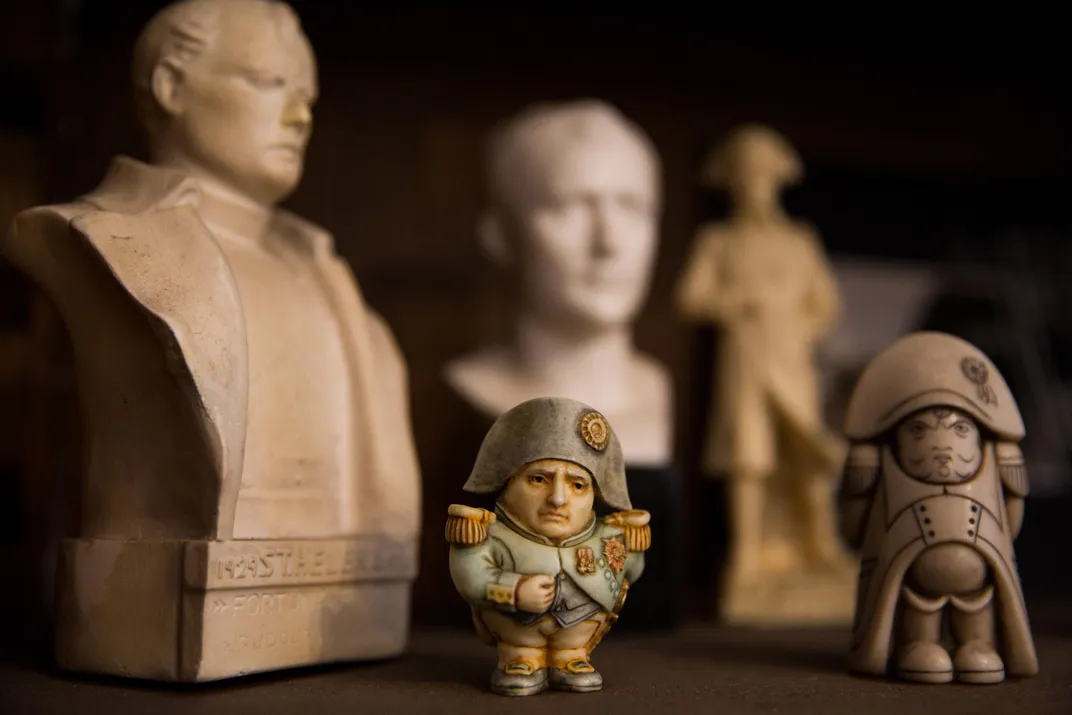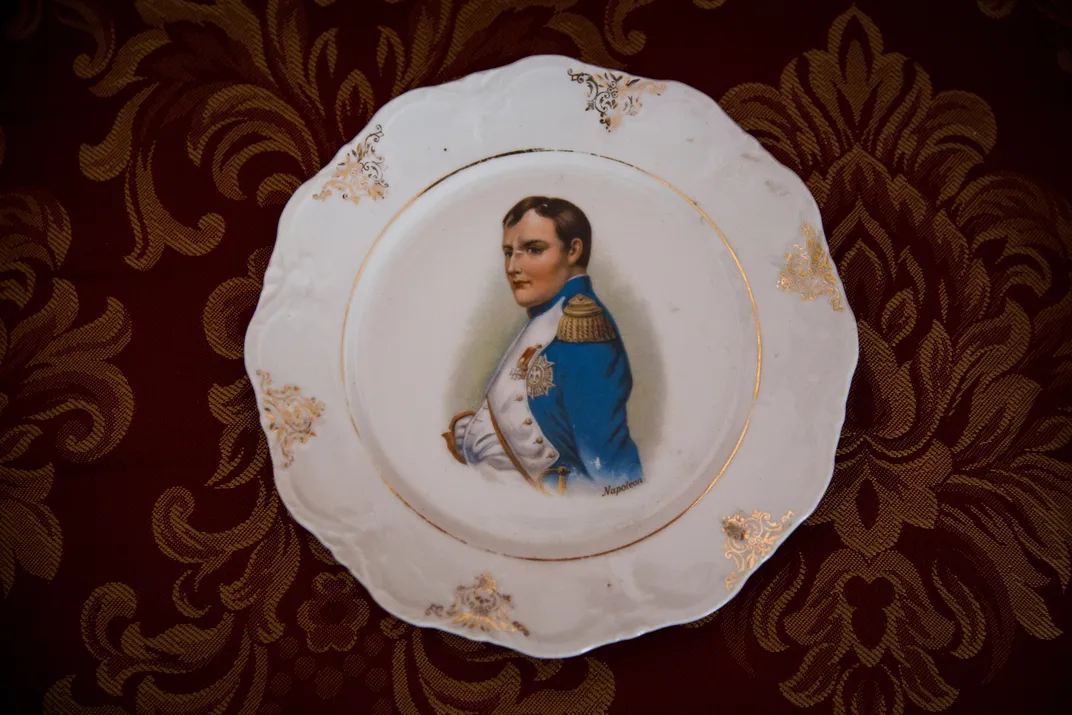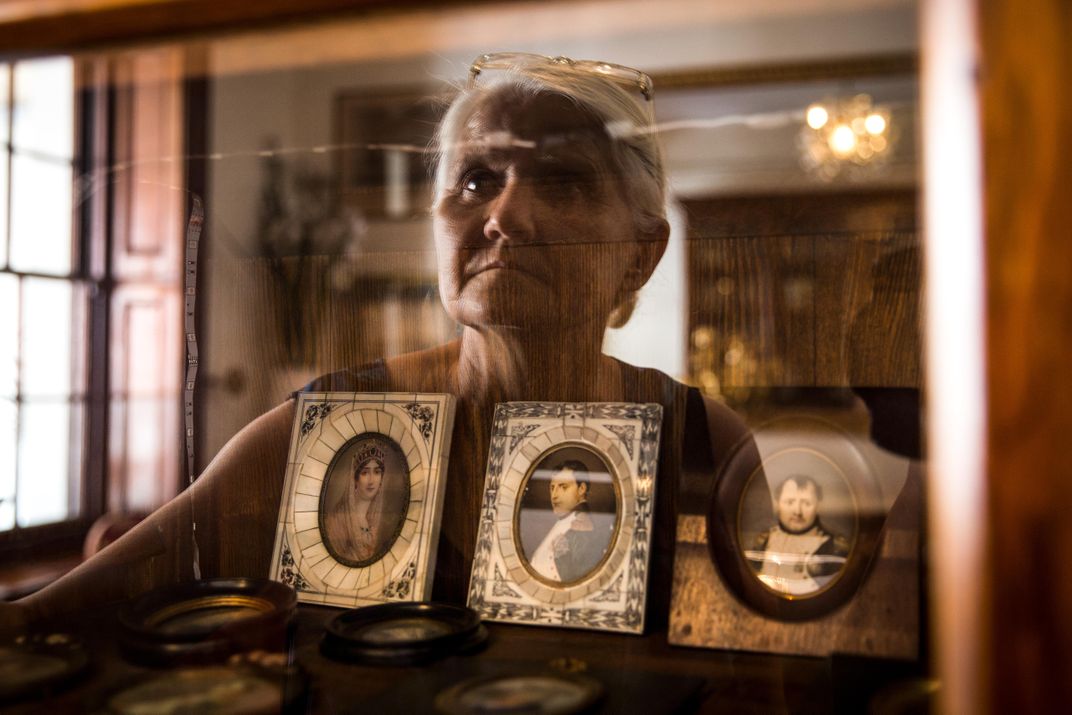“Please, take the emperor’s seat,” says Michel Dancoisne-Martineau. He is tall, handsome and illegally charming. With his glasses and impish smile, he looks every inch the roguish professor you wish you’d had for history class. As the honorary French consul on the British island of St. Helena, he oversees Longwood House, Napoleon Bonaparte’s home in exile from 1815 to 1821, the last years of his life.
Dancoisne-Martineau has already guided us through Longwood’s famous gardens, designed and cultivated by Napoleon himself and bursting with agapanthus flowers that match the blue and white in the French tricolor flying overhead. He leads us into the house through the billiard room, where the banished emperor laid out maps of his campaigns and notes for his memoirs on the table and used cue sticks to move them about. The consul points out the peepholes Napoleon carved into the green shutters with his penknife, so he could peer out at the world without the world seeing him. The holes at that height barely reach our shoulders, hinting at Napoleon’s smaller stature.
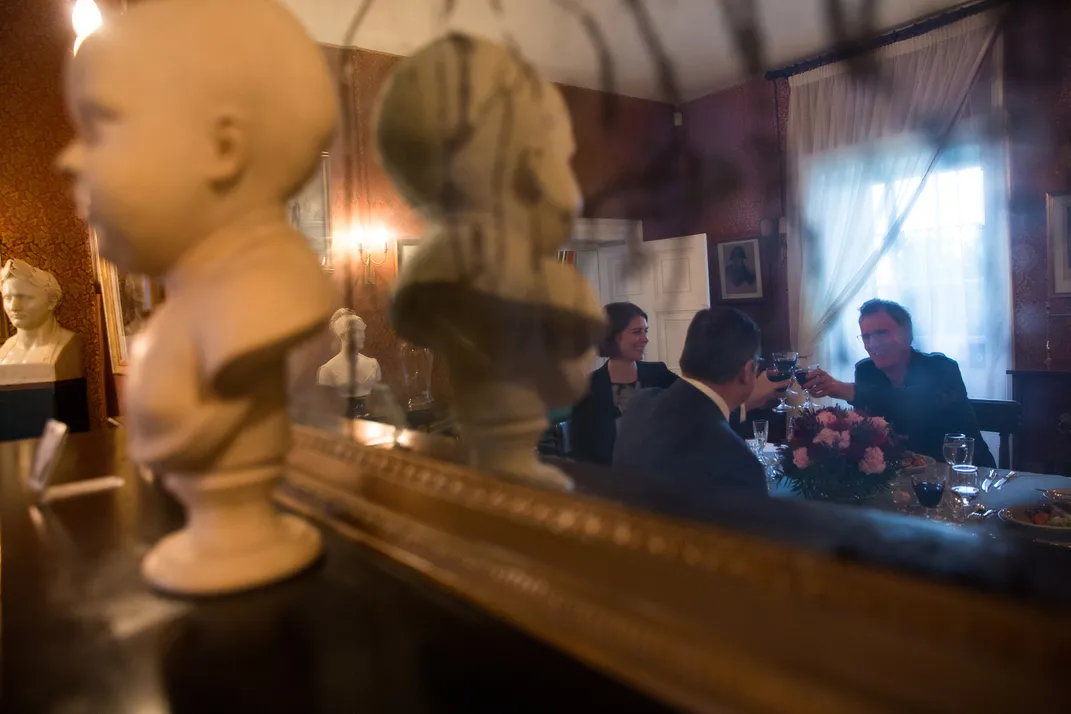
And now Dancoisne-Martineau beckons us into the dining room, which glows with muted light from candelabra on the walls. At the consul’s invitation, James takes the emperor’s seat, in front of the marble fireplace. Erica sits to his right, in the place usually occupied by the Countess de Montholon, one of 28 people who accompanied Napoleon to the island. Samantha Reinders, our photographer, takes the place of the Comte de Las Cases, the principal scribe of the emperor’s memoirs. Dancoisne-Martineau sits opposite James, in the place often taken by Napoleon’s comrade-in-arms, Gaspard Gourgaud.
The consul notes, apologetically, that the table is the one Napoleon used only from 1815 to 1817, because the one he used later is being restored. We furtively lift the tablecloth; highly polished wood gleams beneath. Either way, he says, he has never allowed a dinner to be served on one of the tables before. “But you have come so far,” he says, laughing, “so we make the exception!”
We have come a long way: three flights totaling 20 hours and covering nearly 12,000 miles over four days from our home in Washington, D.C. (Napoleon sailed only 5,000 miles from Europe, but the voyage took two months.) In truth, we wouldn’t have been at the table without the aid of the French ambassador to the United States, Gérard Araud. When we told him we were planning to visit St. Helena, he stopped in his tracks and his face took on a pained, faraway look. “Do you know that the British governor refused to call him ‘emperor’ and would only address him as ‘general’? He had been the head of state of a great nation.”
It was 203 years ago, almost to the day, that Napoleon moved into Longwood House. Here it feels as if the curtain between past and present has been drawn back. It is easy to imagine the man of the hour striding into the room, dressed in the green cavalry jacket of the Imperial Horse Guards, and a white waistcoat adorned with the Legion of Honor—and taking his usual seat at the head of the table with us. Our dinner is a conjuring trick, a historical séance in search of the man whose voice once echoed in this room with tales of war, conquest, glory and defeat, and of vanished dreams of empire and what might have been.
When the emperor sat at this table, he insisted on preserving the protocols of his life at court. Men appeared in military dress, women in evening gowns and gems. It was an explicit denial of the circumstances of his captivity. Tonight, waiters in black suits serve barely seared local tuna, island vegetables and le rosbif; we sip Moët et Chandon Champagne (Napoleon had met the grandson of the brand’s founder, Claude Moët, at military school) and a Honig Cabernet Sauvignon from vineyards in St. Helena, California, decorated with a Napoleonic bee, that we have brought along.
As Napoleon is reputed to have said regarding Champagne, “In victory you deserve it, in defeat you need it.” Here on St. Helena, then, drinking must have been compulsory.
Dancoisne-Martineau tells us, “Some people who come here do not know that Napoleon was a real man. Some think that Napoleon is just a brandy!” But the consul, who is finishing a 12-volume series on the last years of the emperor’s life, adds: “Napoleon was many things—general, emperor, lawgiver, imagemaker, administrator, man of science—what is there for such a man to do on St. Helena?”
* * *
St. Helena measures just 6 by 10 miles and comprises 47 square miles of rocky coastline, colored desert, rippled pastureland and lush cloud forest. This speck of land attained prominence in history precisely because it is in the middle of nowhere: At 1,200 miles west of Angola and 1,800 miles east of Brazil, it is one of the most remote islands on earth.
A Portuguese captain returning from India happened upon it in 1502 and christened it “St. Helena,” for Helena, the mother of Constantine the Great. (To this day, the locals refer to themselves as “Saints.”) The island’s first permanent resident was a mutilated Portuguese soldier named Fernão Lopez, who exiled himself to St. Helena in 1516 and spent 30 years virtually alone.
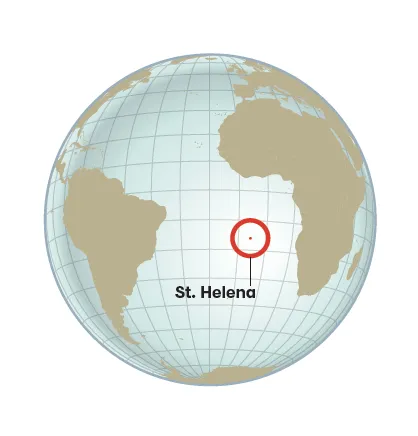
The British seized control of the island in the 17th century and sent settlers; survivors of the 1666 Great Fire of London received grants of land to farm. The Dutch tried to take St. Helena in 1673 and failed, prompting the British to fortify the island with an estimated 230 gun turrets, traces of which still remain. St. Helena today is a British Overseas Territory, like Gibraltar or the Falklands, though in 1858, after years of enmity, the French bought back the two parcels of land containing Longwood House and Napoleon’s grave.
Long before Napoleon arrived, St. Helena had a series of notable visitors. Edmond Halley, of comet fame, made observations in the inky black starlit heavens above the island in 1677. Capt. James Cook stopped by in 1771, as did Capt. William Bligh of Bounty fame in 1792. Arthur Wellesley—better known as the Duke of Wellington, Napoleon’s nemesis at Waterloo—visited on a return trip from India in 1805. “You may tell Bony,” the duke famously wrote to a friend after Napoleon’s arrival on St. Helena, “that I find his apartments at the Elisée Bourbon very convenient, and that I hope he likes mine at Mr. Balcombe’s,” on the island.
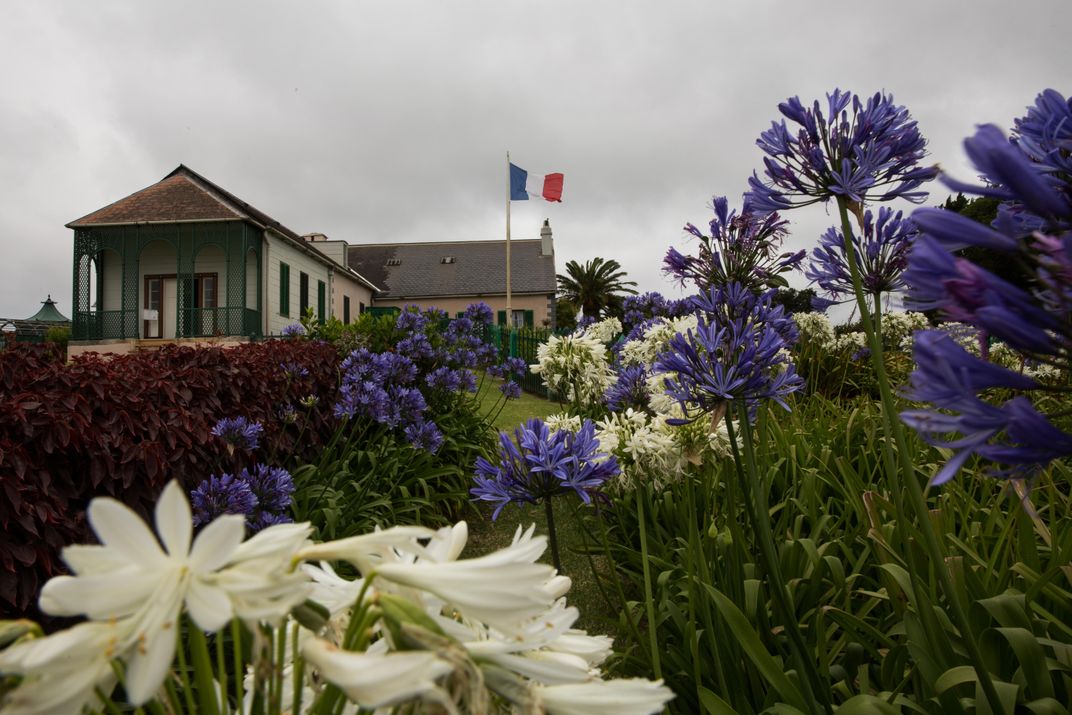
Back at the gardens of Longwood House, we skirt ponds filled with Wedgwood-colored water lilies and a basin curved into the shape of Napoleon’s famous bicorn hat. “Napoleon was a man of water,” Dancoisne-Martineau says as we watch our reflections ripple.
Given that the emperor fought on land (engaging in 60 battles and losing only eight), that might seem far-fetched. But water was continuously intertwined with his fate. Napoleon was born on an island, Corsica, in 1769. Water provided an escape route from his catastrophic Egyptian campaign in 1799. He was exiled to another island, Elba, just six miles off the Italian coast, in 1814. After 300 days he escaped, again by water. That feat led to the Hundred Days campaign (actually, 111 days), during which he launched a reconstituted French Army on a European crusade that left nearly 100,000 men killed or wounded. After his loss at Waterloo, in June 1815, Napoleon was forced to flee France on the high seas.
The defeated emperor briefly considered escaping to America but surrendered to the British, expecting better treatment from them than from the Prussians (whose field marshal, Gebhard Leberecht von Blücher, demanded summary execution). He hoped for asylum on an English country estate, but after the British ship holding him put to sea, he was told that his captors had other plans. The governor of St. Helena was informed by letter: “His Majesty’s Ministers deeply sensitive of the high importance of effectually securing the person of a man whose conduct has proved so fatal to the happiness of the World, [have judged] that the Island of St. Helena is eminently fitted to answer to that purpose.”
Historian Andrew Roberts, whose Napoleon: A Life may be the definitive biography, told us, “When you approach the island by boat, as you get closer and closer and see the rising black rocks, you experience what Napoleon did. You see the totality of what it is. What his fate will be. No wonder Napoleon said, ‘I should have stayed in Egypt.’”
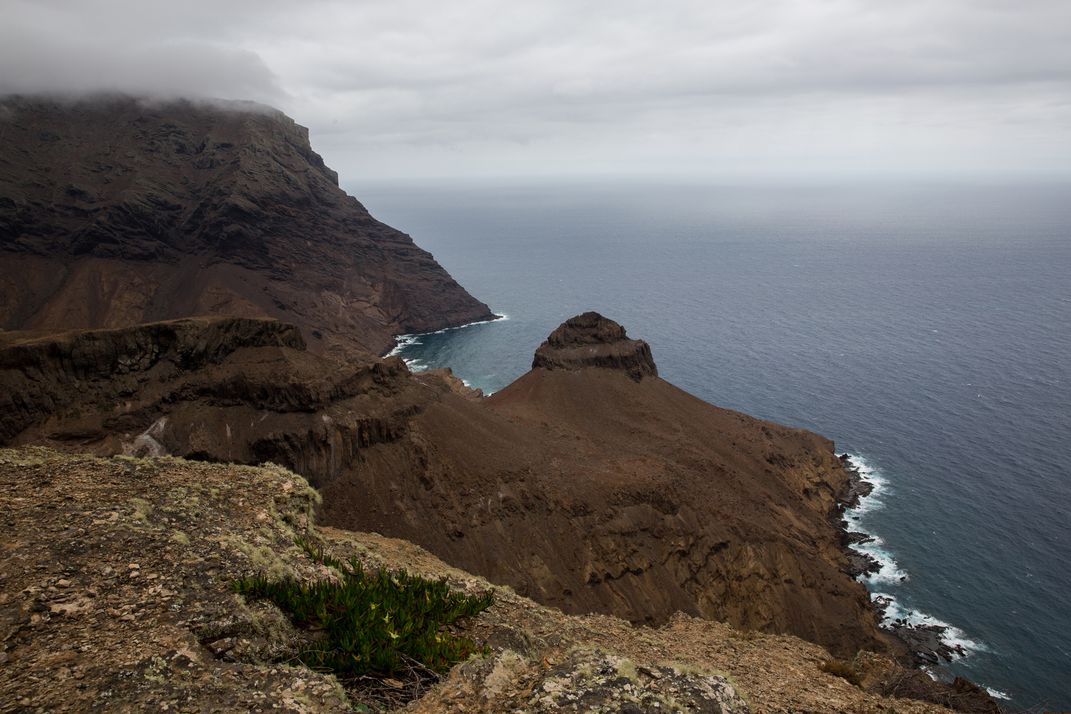
For more than 500 years, visitors shared the same seaborne view of jagged cliffs jutting from the sea like a crown of thorns. The age of the airplane bypassed St. Helena because it offered no flat land for a runway and was consistently buffeted by treacherous winds sweeping off the water. But in the hope of stoking the tourist trade, the British spent almost $400 million to fill in a valley by 2014 with some 800 million pounds of dirt and rock to solve the runway problem and build an airport. The expense, however, did nothing to mitigate the winds. Today, only a special, stripped-down Embraer 190 jet with the best pilots in the world can stick the landing.
After our six-hour flight from Johannesburg, St. Helena appears as an Impressionist’s dot in the infinite blue of the South Atlantic and our spirits begin to rise. Then the pilot took to the intercom and announced, “Do not be alarmed. We will be making a violent turn to land and then pushing the engines to max thrust to avoid the head winds for landing. Cabin crew, take your seats!”
* * *
The ship carrying Napoleon to the island arrived on October 15, 1815, but he was unable to disembark until the night of October 17. And what must Napoleon have thought as the island came into sight, as he scanned its craggy shorelines and the ramshackle houses of Jamestown, St. Helena’s capital (and only) city, with the telescope through which he had surveyed his victories on the battlefields of Europe? As Count de Montholon, who accompanied him into exile, would write, “The valley of Jamestown resembled an entrance to the infernal regions...nothing was to be seen but rows of guns and black cliffs, built as if by a demon’s hand to bind together the rocky peaks.” With only two main streets and 160 dwellings—less than an avenue’s worth of Paris—he must have indeed thought he had arrived in hell.
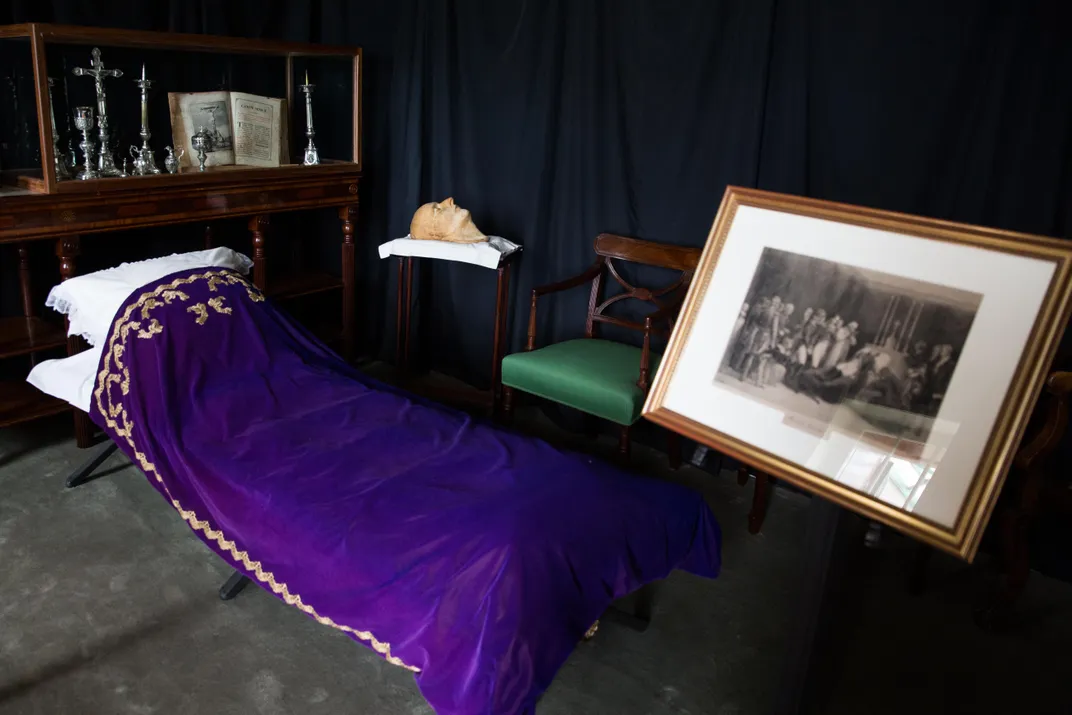
After his first night in Jamestown, he never set foot there again. There was no residence fit for an ex-emperor on the island, so he had to wait seven weeks for a decrepit summer house used by the East India Company to be brought up to snuff. Until then, he stayed with the Balcombe family—who had also hosted Wellington—at their home, the Briars, and fell under the spell of their French-speaking daughter, Betsy. Between games of whist and blindman’s bluff, she may have been the only person ever to box his ears and threaten him with his own sword. He was 46; she was just 13.
These first two golden months at the Briars were his favorite time. Once ensconced at Longwood House, he hosted no cotillions, no grand parties. While protecting his privacy, he was no recluse. In those early days, he was in good health, enjoyed working on his memoirs, received visitors, granted audiences to every important visitor to the island, savored news from the outside world, conversed with British officers, dined with selected visitors, visited people, went on walks and rode horses.
Everything changed with the arrival of the new governor, Hudson Lowe. Lowe sent away Napoleon’s faithful aide Las Cases and banished the sympathetic Balcombes, accusing them of suspicious loyalty to the emperor. Lowe then further restricted the emperor’s freedom of movement, vetted who could visit him, monitored his correspondence, demanded that a British officer chaperone his horseback rides (provoking him to give up riding altogether) and enforced rules that the ex-emperor must be seen in the flesh several times a day by prying British eyes.

Napoleon made a game of it, antagonizing Lowe with cat-and-mouse tricks to hide from sight, terrifying Lowe that he had escaped the island. Napoleon even designed sunken paths in his garden, which still exist today, to make it more difficult for curiosity seekers to glimpse him. The two men met in person only six times, and on one of their last meetings, Napoleon told Lowe, “You are a bigger scourge for us than all the miseries of this frightful rock!”
For a man of movement and momentum, life after Lowe on St. Helena was terrible. Las Cases called him “le moderne Prométhée sur son roc”—the modern Prometheus on his rock. Napoleon suffered on St. Helena as if a golden eagle, released from one of his battle standards, came each day to torture him like the Greek Titan. As Andrew Roberts told us, “St. Helena is an essential part of the Napoleonic myth—because of his ill treatment. It is important that he wrote his autobiography there.”
When he had asked Las Cases what could be done in such a place, the aide had knowingly replied, “We shall live upon the past. There is enough of that to satisfy us.” Thus, for the next 2,027 days, Napoleon could do only that.
* * *
The Saints of today appreciate this legacy. “Napoleon is tops,” Hazel Wilmot tells us. Wilmot owns the Consulate Hotel in Jamestown, which is furnished with a cornucopia of Napoleonica—framed prints, gilt sculptures, souvenirs locked behind glass doors of curiosity cabinets, even a life-size wood carving of the emperor himself standing on the second-floor balcony, surveying Jamestown’s main street. She polls her guests on what brings them to St. Helena, and says Napoleon seems to be the prime attraction. Her hotel, she says, is already sold out for May 2021, the bicentennial of his death.
Still, others believe that obsessing on the emperor is a mistake. “The history of St. Helena is so intricate and interesting, and it’s not fully appreciated,” says Lisa Honan, the current British governor of St. Helena (and first woman to hold the job). “We don’t want the island to be known only for Napoleon.” She says this from a chair in the blue room of her official residence at the 18th-century Plantation House, only footsteps away from a portrait of Britain’s great enemy.
And she is right. The island’s history is so rich and varied as to be unbelievable—so vivid and engaging that it seems fictional, if not lifted straight from a darker fairy tale. It’s been argued that St. Helena was the inspiration for Shakespeare’s The Tempest (see the book by David Jeremiah, former attorney general of St. Helena), but it wouldn’t be out of place for Perrault or Grimm, either.
That history includes the near total destruction of Jamestown in the mid-1800s by termites released by ship breaking. Ahead of his time, in 1818, Governor Lowe freed children born of slaves on the island. After Britain abolished the slave trade, in 1833, the island became a temporary refuge for more than 26,000 Africans liberated by the Royal Navy from slave ships. Some 8,000 of them, victims of the appalling conditions on the ships, are buried in Rupert’s Valley, a narrow chasm next to Jamestown.
At Plantation House, Governor Honan offered us tea but kindly indulged our preference for the island’s legendary coffee. We are not disappointed in the rich, velvety brew, the beans of which came from Yemeni plants first brought to the island in 1733. When Starbucks can get it, it sells for about $80 for an 8.8-ounce bag—perhaps not surprising, since Napoleon said the coffee was the only good thing about St. Helena.
Yet we have come to feel that the real historic markers of the island might be more than its crumbling forts or rusting cannons, but also its living—and breathing—heritage. For example, in the public grounds of the Castle Gardens are gnarled banyan trees that Napoleon would have passed under on his way to his first night on land. At Longwood, two ancient cypress trees hold court over the entrance, and an evergreen oak sweeps its branches to shade the billiard room veranda. Napoleon knew these trees, felt their shade as he wiped sweat from his brow and rested from his garden labors.

Just below Teutonic Hall, a beautiful 18th-century lodge now being restored by Nick Thorpe and his sons, a great Cape Yew tree spreads its ancient branches. Its feathering leaves cloud the sky like a flurry of green ostrich feathers. A keen and encyclopedic preserver of the island’s history, Thorpe tells us that it was under this tree that Napoleon met Miss Polly Mason, famous for her spunk and for riding an ox rather than a horse (nothing but a chance for conversation came of the encounter—that we know of).
And then there’s the Everlasting Daisy, another legacy of Napoleon’s gardening. One of his British admirers, Lady Holland, sent him some seedlings from his garden at Malmaison in Paris to cultivate at Longwood, but the flower quickly spread beyond his control, carpeting the island in glorious yellow blossoms. The sight so outraged a later British governor that he launched an eradication campaign. It failed.

However, the most famous of these living monuments is Jonathan, a nearly two-century-old giant tortoise. He is an international celebrity, having his image on the St. Helena five-pence coin as well as his own Facebook page and Twitter account. Queen Elizabeth II may have seen 13 prime ministers pass through in her reign, but Jonathan has witnessed the coming and going of more than 30 British governors. One can’t help but feel dwarfed in his company, not just by his nearly quarter-ton weight but by his historical presence.
St. Helena is also home to over 500 endemic species, including the endangered wirebird, or St. Helena plover. David Pryce, St. Helena’s self-professed “bug man,” has identified almost 1,400 insects on the island, of which almost 30 percent are endemic. On Diana’s Peak, the island’s highest point, at 2,700 feet above sea level, Lourens Malan, the island’s terrestrial conservation officer, shows us a patch of tiny Tooth-Tongue Ferns rippling out gloriously green fronds, each one hardly bigger than a finger. This is only one of two places in the world where it grows, he tells us. “The other one is over there,” he says, pointing to the adjacent peak.
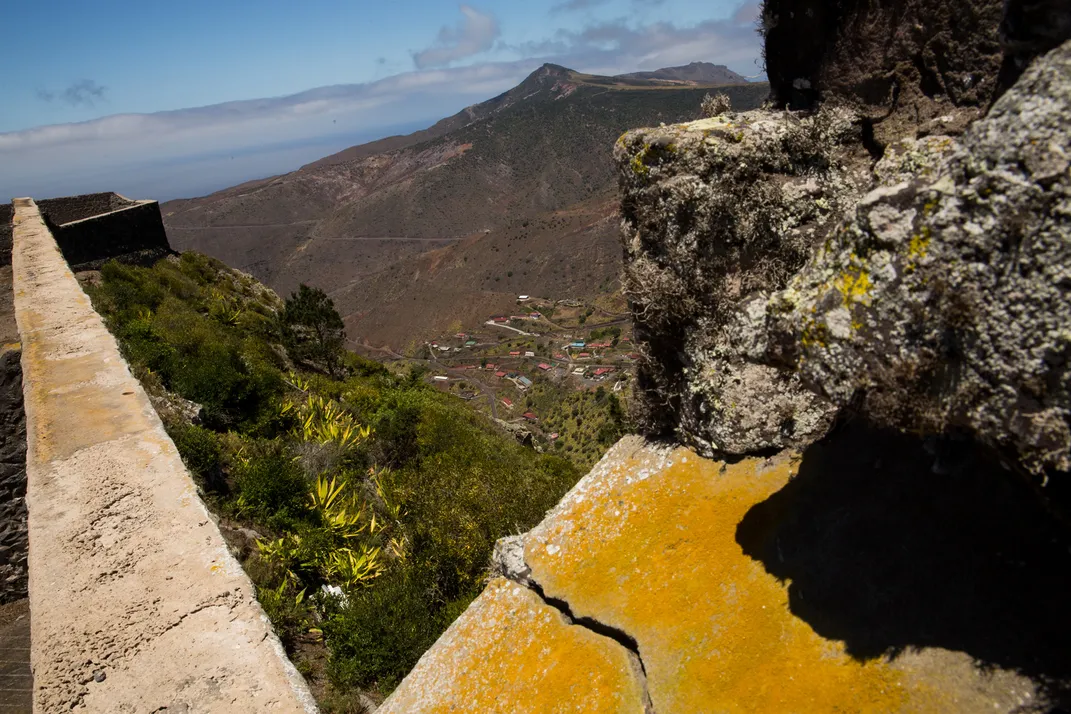
The St. Helena ebony—the national flower—was thought to be extinct until it was found growing on a cliff face in 1980; some brave soul allowed himself to be lowered on a rope to take cuttings, which have been cultivated both on St. Helena and at the Royal Botanic Gardens, Kew. The gumwood, St. Helena’s national tree, survives only in a few places on the island, but both species are being nurtured and replanted in the Millennium Forest, a multiyear project to recreate the “Great Wood” that covered the island before settlers cut down the trees for firewood and ravenous goats ate all the rest.
It struck us that the island’s remoteness can work both ways. To Napoleon—and to some 6,000 Boer prisoners of war held here from 1900 to 1902, and to the 13 Zulus sent here after they protested British rule in South Africa, as well as the three Bahraini nationalists who cooled their heels here from 1957 to 1960, the last foreigners to be exiled here—it was, of course, a place of isolation. To us, it seems like Eden.
* * *
Today we are racing to catch the setting sun with Napoleon. He’s behind the wheel of a battered 4x4, careening around St. Helena’s tortuous byways and finally going off-road to get us to South West Point. In this case, Napoleon is Merrill Joshua, the island’s tourism projects manager.
For the bicentennial of the emperor’s exile, in 2015, the Saints splurged for a full-on, movie-studio-quality Napoleon costume—boots, white breeches, dark hussar jacket, glittering medallions, sword and, of course, bicorn hat. Joshua has been wearing it on special occasions ever since. At a travel-industry trade show in Paris, he was disappointed to learn that, despite Napoleon’s prominence in French history, “it was apparent that no one knew where St. Helena was.”
/https://tf-cmsv2-smithsonianmag-media.s3.amazonaws.com/filer/bc/fc/bcfc436f-096b-4c24-98c6-176bec81a9f0/resized-main-street.jpg)
Joshua stands at the cliff’s edge of South West Point looking out at the endless sea. Though he’s a good deal taller and two decades younger than Napoleon was, he strikes convincingly imperial poses, eyes glued on the far-off horizon as our photographer snaps away—and then quickly puts on his dark sunglasses. He leans back, a Coke in hand, and says that the island is looking forward to 2021. “It will be a great opportunity to educate the world about St. Helena,” he says. But the island will have to find another volunteer Napoleon: Joshua left for England in February.
So from its early illustrious history, where did it all begin to go wrong for St. Helena? As for Napoleon, it began in Egypt. In 1869, the opening of the Suez Canal helped seal St. Helena’s fate, as ships no longer needed a stopping point on a longer journey to Europe. Over a thousand ships a year called at St. Helena in its heyday, but by the turn of the 19th century, barely a fifth of that stopped at the island.
By the 1970s, a majority of Saints were working abroad and sending money home; it became a rite of passage. Even today, the average annual salary is only about 8,000 St. Helena pounds, or $10,000. Hence the British investment in the airport. Weekly flights began in October 2017 with hopes of boosting tourism. But while authorities estimated that the island needed 30,000 tourists per year to become financially sustainable, that hasn’t happened. In its first year, the airport welcomed only 894 visitors.
None of them was an emperor, but they all could do something Napoleon never could: leave the island. After he died, in 1821, apparently of stomach cancer (though conspiracy theories abound), he was buried in a grave dug ten feet deep, lined with bricks and sealed with concrete. For a man who had escaped once in life, the British were taking no chances in death.
After 19 more years, and with a new young Queen Victoria on the throne, unencumbered by memories of the past, the British finally yielded to appeals for his remains to be brought home to France. Today he lies in a grand, colossal tomb in the heart of Paris, and near the Seine, where he longed to rest.
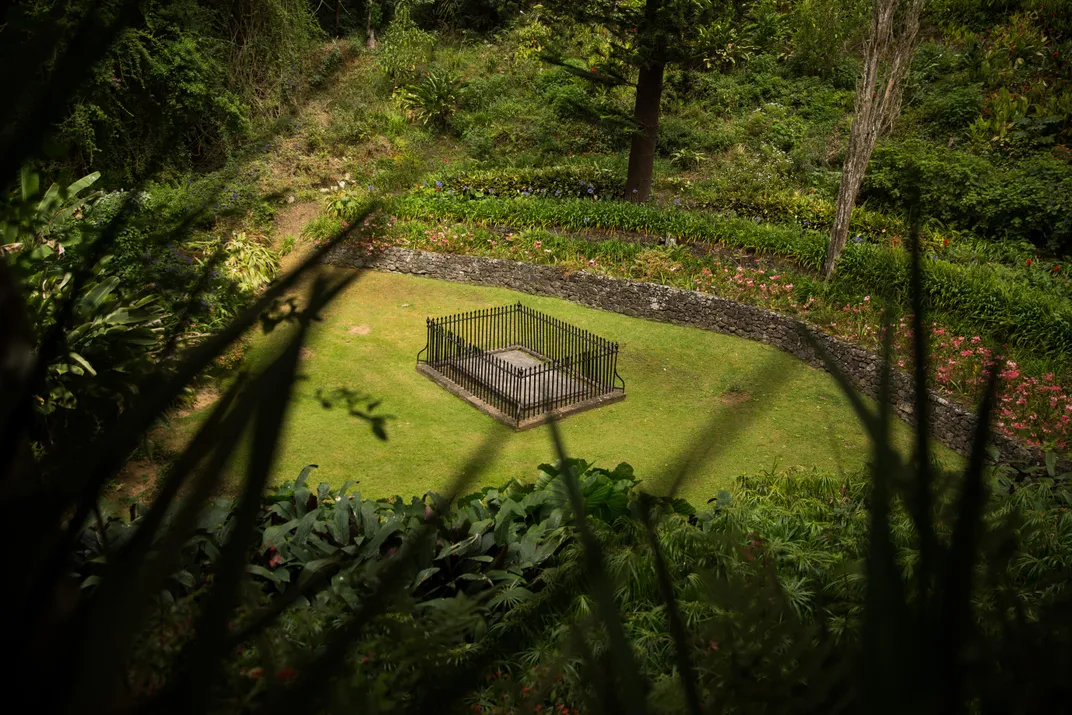
On the day we visit his resting place in Geranium Valley on St. Helena, the site is deserted. A well-maintained walk leads from the road down to a grassy hollow. Black lances of wrought-iron fencing surround the now-empty grave. The French demanded that the tombstone be inscribed “Napoleon,” but the British refused unless “Bonaparte” was added. Thus, the stone remained blank, history unwritten.
* * *
So what would Napoleon think of our visit today? Where does a fallen emperor fit in a world of international air travel and social media? Napoleon lived for communication (he would have loved Facebook and Instagram). Yet here there is only the wind, the sea and the birds above. To us, paradise; to Napoleon, purgatory.
Still the emperor may have the last laugh. As he said of the British, “In 500 years’ time, Napoleon’s name will shine over Europe, whereas yours...will be known only for [the] shame and injustice of [your] conduct to me.” Truly, “Napoleon”—as cognac or conqueror—is common parlance today. And even though his island of exile has not achieved worldwide fame and tourism dollars, that may be more blessing than curse. After all, what is the price of airplane access and swarms of tourists? Is it better that St. Helena stay as it is, in its state of not-then and not-tomorrow, an island enchanted?
On our last morning on the island, we visited Jonathan again. We asked for answers, but in his wisdom of nearly two centuries, he said nothing.
A Note to our Readers
Smithsonian magazine participates in affiliate link advertising programs. If you purchase an item through these links, we receive a commission.
:focal(2413x1124:2414x1125)/https://tf-cmsv2-smithsonianmag-media.s3.amazonaws.com/filer/b3/8b/b38bd343-0e43-4bb0-8b6f-236ada9f8a29/apr2019_e09_sthelena.jpg)
